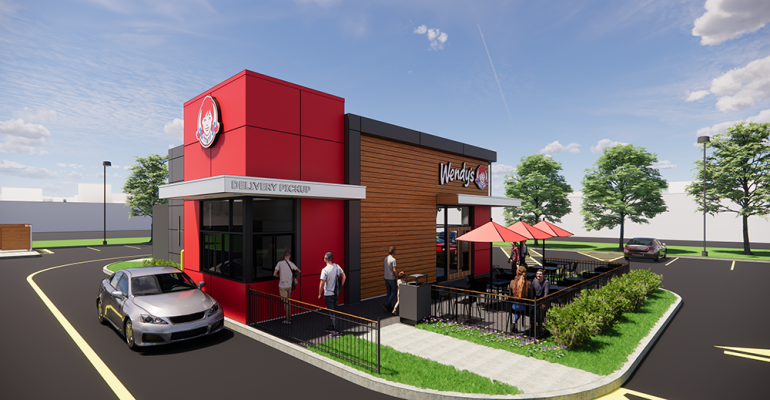The Wendy’s Co. has expanded the number of design options on its development menu as customer habits changed because of the pandemic and as the burger brand targets growth to 8,000 outlets by 2025, according to Abigail Pringle, Wendy’s president for international and chief development officer.
The Dublin, Ohio-based brand, which has about 6,800 units now, is targeting international expansion and offering its 95%-franchised base a suit of options, from drive-thru-only units to dark kitchen and Frosty treat carts to parking-lot transactions centers, Pringle said in a design and development update Wednesday.
“The trends that were coming before the pandemic,” Pringle said. “What COVID did is it accelerated at an unbelievable pace customer behaviors that were already evolving.” She said it was a reminder to those in restaurant design “to stay on our front foot and continue to innovate.”
Among Wendy’s innovations are mobile dark kitchens in Canada and India, drive-thru-only stores in The Philippines, modifications to interior spaces and parking lots to accommodate pickup and delivery orders in the Wendy’s Smart 2.0 design and non-traditional options for franchise owners.
“We've given them a whole suite of options from a container restaurant to modular buildings,” Pringle said, adding that Wendy’s is also offering a franchisee incentive program through June 30 to help grow multi-unit deals.
COVID-19 has also impacted real estate and construction costs, Pringle said.
“Similar to the housing industry, we’re seeing rising costs for construction materials, but the pressures are different across the globe and we are not having access issues,” she said in answers to questions after the event.
“We’re always looking at how we can enhance our designs and we check and adjust as costs change. We have a strong restaurant economic model, and when we add in our most recent development incentives, leverage our great relationship with QSCC (our supply chain co-op) and our Design to Value initiative to help us to find ways to save money without affecting the customer experience, the returns are compelling.”
Pringle said prices in real estates are competitive, but the brand keeps in mind that “developers and landlords factor many things into their economic model.” One strength for Wendy’s, she added, is that “many of our commitments for traditional real estate are usually 20 years, that also allows us to build lasting relationships with our landlords and helps us secure great properties.”
Design also has to cater to customers’ reliance on digital smartphone apps and delivery, Pringle said.
Design “should be easy” for the customer to get orders as well, she said. “It should be fast. It should be tailored for each customer. And really, I think, help take our parking lots and turn them into transaction centers. I think that's an important around our great partnerships also with delivery partners.”
For the first quarter ended April 4, Wendy’s net income was $41.4 million, or 18 cents a share, compared to $14.4 million, or six cents a share, in the prior-year period. Revenues were $460.2 million compared to $405 million in the first quarter last year.
Same-store sales were up 13.5% after being flat in the first quarter of 2020.
Wendy's, founded in 1969, has more than 6,800 restaurants worldwide.
Here’s a look at some of Wendy’s new non-traditional units and anticipated openings.
Contact Ron Ruggless at [email protected]
Follow him on Twitter: @RonRuggless




